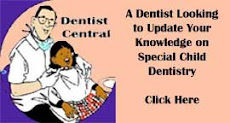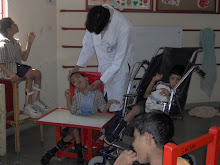What is Drooling?
Drooling is basically the escape of excess saliva from the mouth. Drooling is seen commonly in normal infants, it usually subsides by 15-18 months of age as a consequence of physiological maturity of oro-facial motor function.Although drooling may, in some rare cases, persist in a normal child, its presence beyond the age of 4 years must be considered abnormal. Some investigators believe that individuals may have both an increased salivation and decreased or ineffective swallowing , while other studies and reviews of literature show that drooling is mainly due to a swallowing defect caused by poor neuromuscular coordination. Drooling of saliva is seen in a wide spectrum of disorders most of which have poor neuromuscular neuromuscular coordination such as Cerebral Palsy, Parkinsons disease or Amyotrophic lateral sclerosis (ALS).
Why Treat Drooling ?
Drooling of saliva has been shown to cause both psychological problems and problems such as irritation or maceration of the skin, increased perioral infection, a foul smelling odor and dehydration due to fluid and nutrient loss. Drooling can also cause impairment of speech and masticatory function and leads to an increased chance of peri-oral infection especially Candida albicans. Severe drooling may also result in aspiration pneumonia. Traditional methods of controlling drooling such as Surgically repositioning salivary gland ducts or drugs to control drooling have often lead to serious side effects such as dryness of mouth, severe dental caries, dysphagia or burning mouth. Methods that do not reduce salivary flow such as biofeedback and appliances while promising have not been tested on a large scale.
What is Botulinim Toxin ?
Botulinim toxin or neurobotulinum toxin serotype A (NBS)is a toxin produced by the Gram negative anaerobic bacteria Clostriduim botulinum. It's action is based on the inhibition of acetylcholine release at the pre-synaptic level. While the resultant loss of neuronal tone causes muscle flacidity and is responsible for the disappearance of wrinkles it's actions on the salivary glands is quite different.
Botulinum toxin in the treatment of drooling
The cholinergic system stimulates the production of saliva. Systemic Anticholinergic drugs such as atropine have long been used to control excessive salivation for short periods of time such as during dental treatment. However the use of these drugs have a systemic component thus inhibiting their use in long term therapy. Botulinum toxin by means of it's anticholinergic action inhibits the salivary flow. However when injected into the the desired site it has an almost completely local action with minimal systemic complications.
Technique
Neurobotulinum toxin serotype A (NBS) is commercially marketed in two forms, the older Botox (Allergan inc. Irvine USA) and a more recent formulation Dysport (Speywood pharma Maindenhead UK). One unit of Botox is equivalent to 3 or 4 units of Dysport.
Site of Injection The toxin may be injected into the Parotid or Submaxillary salivary gland. Some authors have advocated injection into both the parotid and submaxillary gland.
Dose The total dose varies from 10- 100 Units of Botox or 30 to 450 units of Dysport divided between the glands and the sites of injection. The toxin is injected in divided doses in two separate sites of the gland using ultrasound guidance under general anesthesia.
Is it effective?
Studies on children with cerebral palsy and on individuals with Amyotrophic Lateral Sclerosis (ALS) have shown promising results.
While all research has shown a decrease in drooling and improvement in quality of life few authors have pointed out the risk of dry mouth at doses higher than 40 U of Botox ( 120 U Dysport). One study study on patients with cerebral palsy found a complaint of Dysphagia in 2 patients while another study on patients with ALS reported one case of recurrent mandibular luxation after injection into the parotid gland.
Each injection was effective for between 3 to 6 months.
While there is still much research to be done in this field Botulinum toxin looks to offer hope to patients with the embarrassing and sometimes dangerous problem of drooling of saliva.
What is Botulinim Toxin ?
Botulinim toxin or neurobotulinum toxin serotype A (NBS)is a toxin produced by the Gram negative anaerobic bacteria Clostriduim botulinum. It's action is based on the inhibition of acetylcholine release at the pre-synaptic level. While the resultant loss of neuronal tone causes muscle flacidity and is responsible for the disappearance of wrinkles it's actions on the salivary glands is quite different.
Botulinum toxin in the treatment of drooling
The cholinergic system stimulates the production of saliva. Systemic Anticholinergic drugs such as atropine have long been used to control excessive salivation for short periods of time such as during dental treatment. However the use of these drugs have a systemic component thus inhibiting their use in long term therapy. Botulinum toxin by means of it's anticholinergic action inhibits the salivary flow. However when injected into the the desired site it has an almost completely local action with minimal systemic complications.
Technique
Neurobotulinum toxin serotype A (NBS) is commercially marketed in two forms, the older Botox (Allergan inc. Irvine USA) and a more recent formulation Dysport (Speywood pharma Maindenhead UK). One unit of Botox is equivalent to 3 or 4 units of Dysport.
Site of Injection The toxin may be injected into the Parotid or Submaxillary salivary gland. Some authors have advocated injection into both the parotid and submaxillary gland.
Dose The total dose varies from 10- 100 Units of Botox or 30 to 450 units of Dysport divided between the glands and the sites of injection. The toxin is injected in divided doses in two separate sites of the gland using ultrasound guidance under general anesthesia.
Is it effective?
Studies on children with cerebral palsy and on individuals with Amyotrophic Lateral Sclerosis (ALS) have shown promising results.
While all research has shown a decrease in drooling and improvement in quality of life few authors have pointed out the risk of dry mouth at doses higher than 40 U of Botox ( 120 U Dysport). One study study on patients with cerebral palsy found a complaint of Dysphagia in 2 patients while another study on patients with ALS reported one case of recurrent mandibular luxation after injection into the parotid gland.
Each injection was effective for between 3 to 6 months.
While there is still much research to be done in this field Botulinum toxin looks to offer hope to patients with the embarrassing and sometimes dangerous problem of drooling of saliva.






